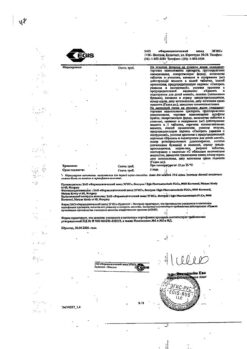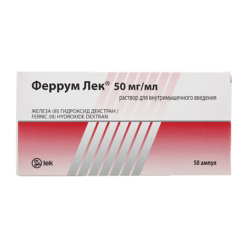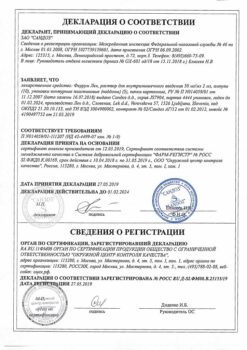No products in the cart.
Iron (III) hydroxide sucrose complex, 20 mg/ml 5 pcs 5 pcs
€94.66 €82.04
Description
Pharmacotherapeutic group:
Pharmacotherapy group:
ATC:
B.03.A.C.02 Iron oxide saccharate
Pharmacodynamics:
The multinuclear centers of iron (III) hydroxide are surrounded by many noncovalently bound sucrose molecules on the outside. This results in a complex with a molecular weight of approximately 43 kDa, making it impossible to excrete it unchanged through the kidneys.
This complex is stable and does not release iron ions under physiological conditions. The structure of the multinuclear iron-containing nucleus is similar to that of ferritin, the physiological iron depot. This complex is designed to create a controlled source of utilizable iron for transferrin and ferritin, which are responsible for transport and deposition of iron in the body.
After intravenous administration, iron from this complex is taken up primarily by the liver, spleen and bone marrow and then used for the synthesis of hemoglobin, myoglobin and other iron-containing enzymes, or stored in the liver in the form of ferritin.
Pharmacokinetics:
After a single intravenous administration of Iron [III] hydroxide sucrose complex containing 100 mg of iron, maximum iron concentration, averaging 538 μmol, is reached 10 minutes after injection. The distribution volume of the central chamber corresponds almost completely to the volume of serum (about 3 liters).
The elimination half-life is about 6 h. The volume of distribution in equilibrium is approximately 8 L, indicating low iron distribution in body fluids, due to the low stability of iron sugars compared to transferrin, there is a competitive exchange of iron in favor of transferrin and as a result, about 31 mg of iron is transported in 24 h.
The renal excretion of iron for the first 4 h after injection is less than 5% of total clearance. After 24 h, serum iron levels return to the original (pre-injection) value and approximately 75% of sucrose leaves the vascular stream.
Indications
Indications
Iron [III] hydroxide sucrose complex is used to treat iron deficiency conditions in the following cases:
if you need to quickly replenish iron;
in patients who cannot tolerate oral iron supplements or do not comply with treatment;
in the presence of active inflammatory bowel diseases, when oral iron supplements are ineffective.
Pharmacological effect
Pharmacological effect
Pharmacotherapeutic group:
Iron supplement
ATX:
B.03.A.C.02 Iron oxide saccharate
Pharmacodynamics:
The polynuclear iron(III) hydroxide centers are surrounded on the outside by many non-covalently bound sucrose molecules. As a result, a complex is formed, the molecular weight of which is approximately 43 kDa, as a result of which its excretion through the kidneys in unchanged form is impossible.
This complex is stable and does not release iron ions under physiological conditions. The structure of the multinuclear iron-containing core is similar to the structure of the ferritin core, a physiological iron depot. This complex is designed to create a controlled source of utilized iron for transferrin and ferritin, which are responsible for the transport and storage of iron in the body.
After intravenous administration, iron from this complex is taken up primarily by the liver, spleen and bone marrow and is then used for the synthesis of hemoglobin, myoglobin and other iron-containing enzymes, or stored in the liver in the form of ferritin.
Pharmacokinetics:
After a single intravenous administration of the drug Iron [III] hydroxide sucrose complex containing 100 mg of iron, the maximum concentration of iron, on average 538 μmol, is achieved 10 minutes after injection. The volume of distribution of the central chamber almost completely corresponds to the volume of serum (about 3 l).
The half-life is about 6 hours. The volume of distribution at steady state is approximately 8 liters, which indicates a low distribution of iron in body fluids. Due to the low stability of iron sucrose in comparison with transferrin, there is a competitive exchange of iron in favor of transferrin and as a result, about 31 mg of iron is transferred in 24 hours.
Iron excretion by the kidneys during the first 4 hours after injection is less than 5% of the total clearance. After 24 hours, the serum iron level returns to its original (pre-administration) value, and approximately 75% of sucrose leaves the vascular bed.
Special instructions
Special instructions
Iron [III] hydroxide sucrose complex should be prescribed only to those patients in whom the diagnosis of anemia is confirmed by appropriate laboratory data (for example, the results of determining serum ferritin or hemoglobin and hematocrit levels, the number of erythrocytes and their parameters – the average volume of an erythrocyte, the average content of hemoglobin in an erythrocyte or the average hemoglobin concentration in an erythrocyte).
Intravenous iron supplements may cause allergic or anaphylactoid reactions, which can be potentially life-threatening.
The rate of administration of the drug Iron [III] hydroxide sucrose complex should be strictly observed (with rapid administration of the drug, blood pressure may decrease). A higher incidence of undesirable side effects (especially lowering blood pressure), which can also be severe, is associated with an increase in dose. Thus, the dosage and administration times given in the Dosage and Administration section must be strictly followed, even if the patient is not receiving the maximum tolerated single dose.
Studies conducted in patients with hypersensitivity reactions to iron dextran showed the absence of complications during treatment with iron [III] hydroxide sucrose complex preparations.
Penetration of the drug into the perivenous space should be avoided, because entry of the drug Iron [III] hydroxide sucrose complex outside the vessel leads to tissue necrosis and brown discoloration of the skin. If this complication develops, to accelerate the removal of iron and prevent its further penetration into surrounding tissues, it is recommended to apply heparin-containing drugs to the injection site (gel or ointment is applied with light movements, without rubbing).
Shelf life after first opening the container: From a microbiological point of view, the drug should be used immediately.
Impact on the ability to drive vehicles. Wed and fur.:
It is unlikely that the drug Iron [III] hydroxide sucrose complex may have an undesirable effect on the ability to drive a car and operate machinery. However, if symptoms such as dizziness, confusion or fainting develop, patients should not drive vehicles or operate machinery until these symptoms disappear.
Active ingredient
Active ingredient
Iron III hydroxide sucrose complex
Composition
Composition
Each ampoule contains:
Contraindications
Contraindications
The use of the drug Iron [III] hydroxide sucrose complex is contraindicated if:
anemia is not associated with iron deficiency;
there are signs of iron overload (hemosiderosis, hemochromatosis) or a violation of the process of its utilization;
there is hypersensitivity to the drug Iron [III] hydroxide sucrose complex or its components;
I trimester of pregnancy.
With caution:
Patients with bronchial asthma, eczema, polyvalent allergies, allergic reactions to other parenteral iron preparations and persons with low serum iron-binding capacity and/or folic acid deficiency Iron [III] hydroxide sucrose complex should be prescribed with caution.
Caution is also required when administering iron supplements to patients with liver failure, acute or chronic infectious diseases, and individuals with elevated serum ferritin levels due to the fact that parenterally administered iron may have an adverse effect in the presence of a bacterial or viral infection.
Side Effects
Side Effects
The most frequently reported adverse drug reactions with the use of Iron [III] hydroxide sucrose complex preparations were changes in taste, decreased blood pressure, pyrexia and chills, reactions at the injection site and nausea.
Very common (> 1/10), common (> 1/100 – 1/1000-1/10000 – < 1/100), very rare (< 1/10000), frequency unknown (it is impossible to estimate their frequency from the available data).
From the immune system
Rare: anaphylactoid reactions.
From the nervous system
Frequent: taste disturbances. Uncommon: dizziness, headache. Rare: paresthesia, fainting, loss of consciousness, burning sensation. Frequency unknown: decreased levels of consciousness, confusion.
From the side of the heart
Uncommon: tachycardia, palpitations. Unknown: bradycardia.
From the side of blood vessels
Uncommon: decreased blood pressure. vascular collapse. Rare: increased blood pressure.
From the respiratory system, chest cavity and mediastinum
Uncommon: bronchospasm, shortness of breath.
From the gastrointestinal tract
Uncommon: nausea, vomiting, abdominal pain, diarrhea.
From the skin and subcutaneous tissues
Uncommon: pruritus, urticaria, rash, erythema
From the musculoskeletal system and connective tissue
Uncommon: muscle spasms, muscle pain.
Rare: joint swelling, joint pain.
General disorders and reactions at the injection site
Uncommon: pyrexia, chills, hot flashes, labor pain, injection site reactions (eg, superficial phlebitis and edema). Rare: angioedema, peripheral edema, fatigue, asthenia, general malaise, feeling of heat, edema. Very rare: hyperhidrosis, back pain. Unknown: Chromaturia.
Interaction
Interaction
Iron [III] hydroxide sucrose complex should not be prescribed simultaneously with dosage forms of iron for oral administration, as it helps to reduce the absorption of iron from the gastrointestinal tract. Treatment with oral iron supplements can be started no earlier than 5 days after the last injection.
The preparation Iron [III] hydroxide sucrose complex can be mixed in one syringe only with a sterile 0.9% sodium chloride solution. Incompatible with other intravenous solutions and therapeutic drugs due to the risk of precipitation and/or other pharmaceutical interactions. Compatibility with containers made of other materials (polyethylene and polyvinyl chloride), with the exception of glass, has not been studied.
Overdose
Overdose
Overdose can cause acute iron overload, which manifests itself as symptoms of hemosiderosis.
Storage conditions
Storage conditions
In a place protected from direct sunlight at a temperature not exceeding 25 °C.
Keep out of the reach of children.
Shelf life
Shelf life
3 years.
Manufacturer
Manufacturer
Pharmstandard-UfaVITA, Russia
Additional information
| Shelf life | 3 years. |
|---|---|
| Conditions of storage | In the protected from light place at a temperature no higher than 25 ° C. Keep out of reach of children. |
| Manufacturer | Pharmstandard-UfaVITA, Russia |
| Medication form | solution |
| Brand | Pharmstandard-UfaVITA |
Related products
Buy Iron (III) hydroxide sucrose complex, 20 mg/ml 5 pcs 5 pcs with delivery to USA, UK, Europe and over 120 other countries.















